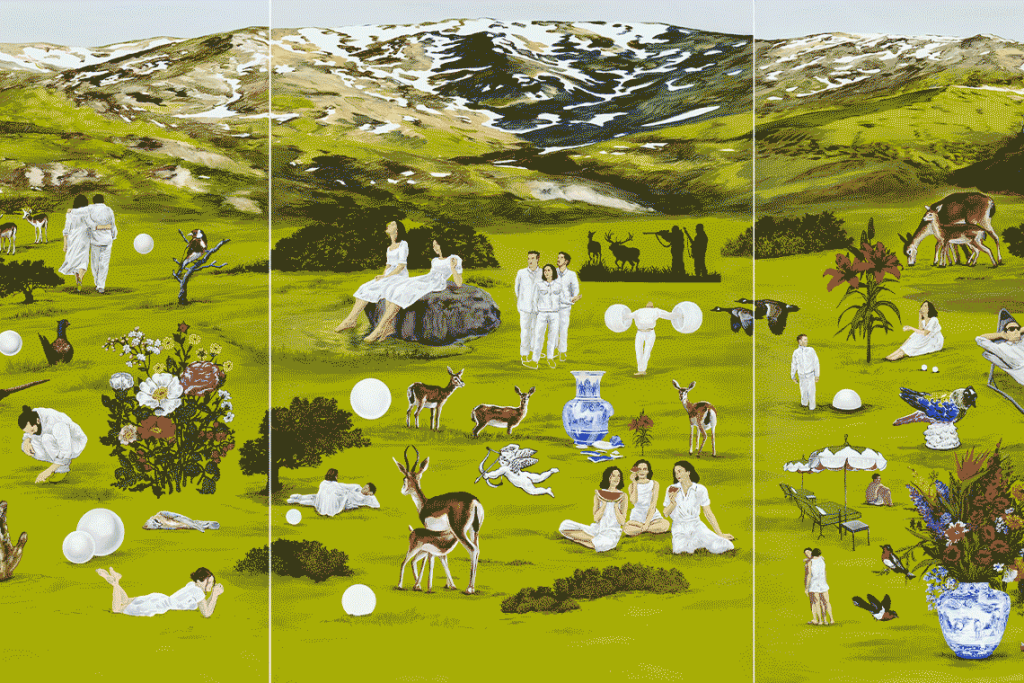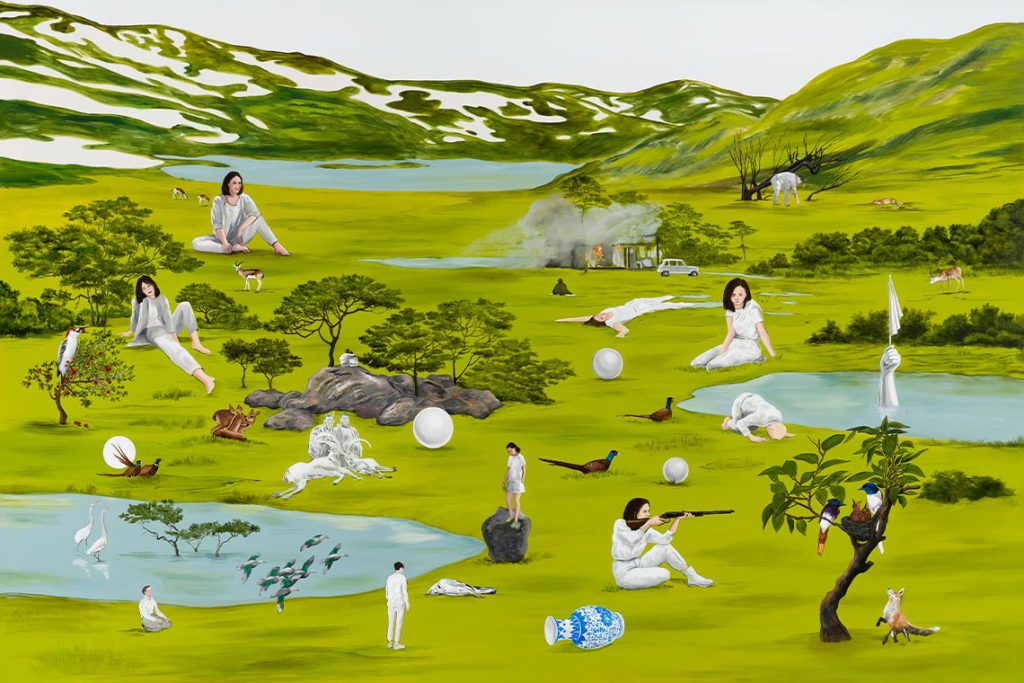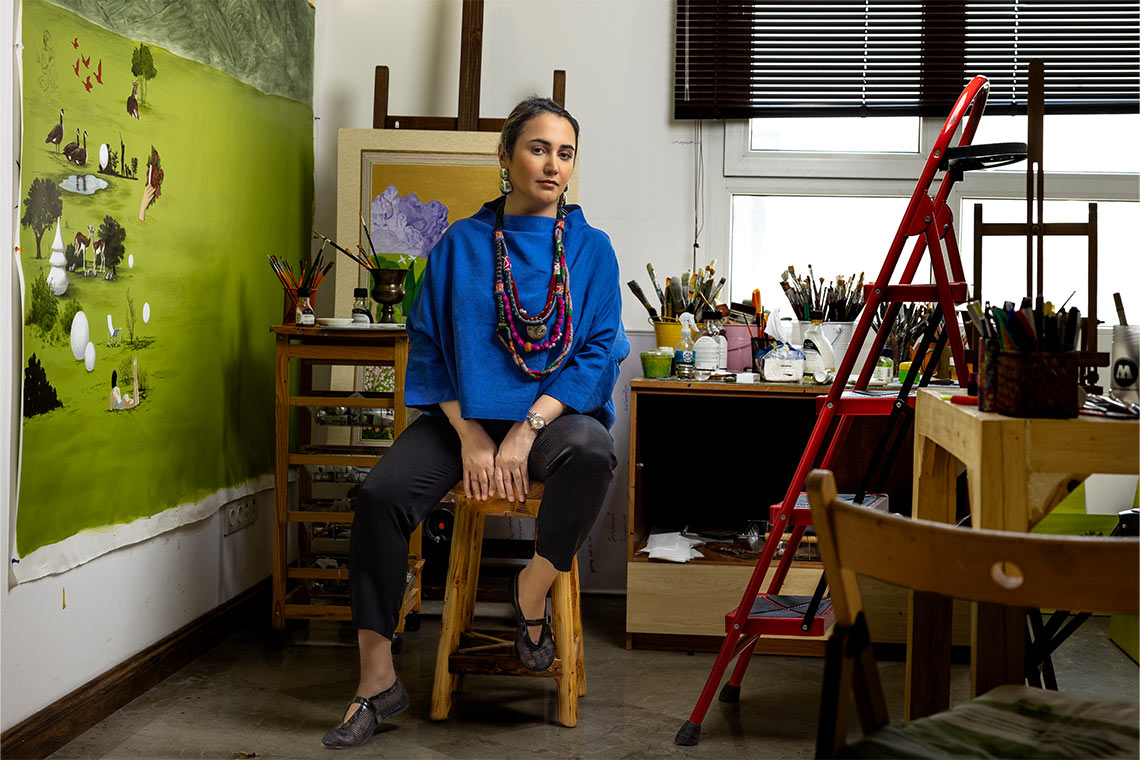Rooted in personal reflection and nostalgia, the artist transforms familiar landscapes from her homeland of Iran into surreal, symbolic spaces.
Canvas: It is fascinating how art can convey deep emotion. How do you translate complex human emotions into visual representations of landscapes?
Mahsa Tehrani: My creative process starts with introspection, drawing from my own thoughts and memories. On a deeper level, I acknowledge that my work reflects my voice as I explore profound themes of life, birth and death. Painting is my language to connect with the audience on an emotional level and create a shared understanding of our collective human experience.
In your paintings, for example A Land of Magnets and Miracles (2023), we can see figures dressed in white and others who are almost statue-like. How does colour relate to their mental or physical states?
I choose white for the figures’ dresses because it imbues them with a universal quality, allowing them to exist beyond specific times or places – timeless and placeless. This simplicity creates a striking contrast with the lush greenery behind them, making the figures pop as focal points. The white represents calmness and fragility, which invites viewers to pause and reflect. One of my intentions is to create a space where viewers can project themselves onto these figures. I often hear people at my exhibitions express a sense of déjà vu, a feeling that they belong in these landscapes, even if they have never set foot in them.
The colours you use for your landscapes are often vibrant and dream-like. What do they signify?
When I paint landscapes, they are not just about capturing the beauty but also a deeper reflection of my feelings and experiences. I infuse each scene with my memories, dreams and the rich traditions of Iran. At first glance, the viewer may appreciate the aesthetic qualities, but there’s more beneath the surface.
As you look closer, the figures and elements within the landscape evoke a sense of unease. This contrast adds layers to the experience, prompting the audience to confront their emotions and thoughts. The tension between beauty and discomfort makes the work resonate on a more profound level, inviting a deeper exploration of both the landscape and oneself.

Are there particular landscapes or natural elements that appeal to you?
My paintings often feature landscapes inspired by various regions of Iran, particularly the Zagros and Alborz Mountain ranges surrounding my home city of Tehran. These familiar scenes evoke a sense of nostalgia and reflect a deeper emotional landscape, connecting me to my roots. Through my work, I explore a complex range of emotions. For instance, the green fields convey openness and tranquillity, while the juxtaposition of oversized objects – such as porcelain figures and animals – shifts the serenity of the landscape into the realm of surrealism, creating a space that invites wonder and curiosity. I always enjoy blending the familiar with the unfamiliar. The contrast encourages reflection and connection, inviting viewers to explore their emotions and memories within the landscapes I create.
Do you draw inspiration from Persian miniature painting in your work?
When I noticed the similarities between my work and Persian miniature painting, I was inspired to delve deeper into the techniques and history. A striking quality is its ability to depict multiple scenes and perspectives simultaneously. I aim to incorporate this element into my paintings, creating a sense of layered reality. In Persian art, there is a concept called ‘narrow sky’, which captures a sense of closeness and intimacy with the environment. This idea resonates with me and I’m consciously working to integrate these influences into my art.

You frequently reference blue-and-white porcelain vases. Where does this inspiration come from?
I like to incorporate classical elements that viewers might recognise as familiar motifs and relate them to something similar that they may have in their own homes. I love the feeling of connection it creates, as it fosters a share experience. When I first began painting these elements, it was purely because I was drawn to them. I’d start with an object simply because I liked it, without overthinking. As I continued to work, however, layers of meaning would emerge. I’d find myself reflecting on why these objects resonated with me and what they represented. Sometimes, there are elements I might not initially be fond of, but I paint them anyway, trusting that there’s something valuable to uncover.
How do the figures and animals in your paintings engage with each other? What influences your decisions regarding their connections?
My work often explores themes surrounding animals that are going extinct, inspired by the conservationists I’ve followed on social media for years. Seyed Bagheri Mousavi was among the first whose posts captured my attention. Through various wildlife conservation pages, I’ve collected images of these creatures and drawn parallels between their struggles and our own challenges. Both are deeply affected by the choices made by others, impacting their quality of life, freedom and even their very existence – decisions in which they have no say. In my paintings, these animals can appear in various states – sometimes they are depicted as lifeless, at other times they are playful or simply observing their surroundings. This diversity allows me to create rich, imaginative worlds where these creatures coexist with our realities. By weaving their narratives into my art, I not only highlight the fragility of their existence but also reflect on our shared experiences of hardship and resilience.
This interview first appeared in Canvas 115: On the Wild Side



